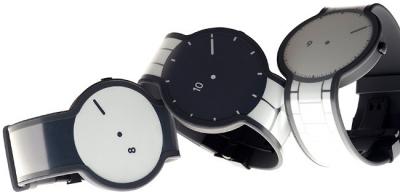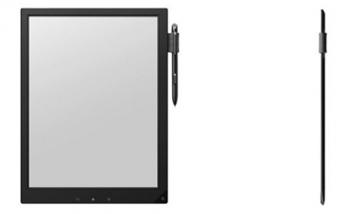FlexEnable demonstrate their OTFT-based flexible E Ink technology
FlexEnable (recently spun-off from PlasticLogic) demonstrated their OTFT-based flexible displays, including E Ink, LCD and OLED display:
FlexEnable (recently spun-off from PlasticLogic) demonstrated their OTFT-based flexible displays, including E Ink, LCD and OLED display:
The FES Watch is a new crowdfunding campaign in Japan that aims to develop a smartwatch that is covered with E Ink panels - not only for the watch face but also for the straps. This allows you to reach a high degree of customization while keeping power consumption low.

According to the company's plan, the FES Watch will ship in May 2015.
Archos are showing three new smartwatches. The two budget ones (at $50 and $85) use LCD displays, but the high-end one uses an E Ink panel.
The premium model (which will cost $130) uses a 1.8" curved E Ink display. The battery will last 1.5 weeks. The watch will display the time, notifications from your smartphone and media controls.
IRX Innovations was established by ex-Philips employees (that developed Philips' E Ink technologies) to develop EPD products. The company is now developing a technology they call Electro Osmosis which is similar to E Ink (electrophoresis) but the big difference is that the liquid that contains the charged particles also move inside the pixels in Electro Osmosis (in electrophoresis only the charged particles are moving). This enables much faster refresh rates.
The company is currently developing a prototype black and white display, but they are aiming towards color. They expect the displays to have similar properties as E Ink, but with better contrast and much better color gamut.
Researchers from the University of Washington, the University of Massachusetts and Intel Labs developed an E Ink display that is powered wirelessly using NFC. They used an NFC tag that includes a wireless power harvester microchip and 1mAh battery (to capture and store the energy). The E Ink display is 2.7" in size.
A single NFC transfer can be used to get 0.5Mb of data - or about 20 pages, and it gives energy enough to view all of those pages - several times over.
The Human Media Lab at Queenâs University in Ontario's new project, DisplayStacks, uses several flexible E Ink panels together that communicate between them using sensors to integrate them into a compound display.
The researchers explain that DisplayStacks basically enables physical stacking of digital documents via piles of flexible E Ink displays. With a conductive dot pattern sensor attached to the flexible dis- play, the system dynamically tracks the position and orientation of these displays in relation to one another. This enables several asymmetric bimanual interaction mechanisms for access and manipulation of information.
The Good E-Reader site posted a review of Seiko's SBPA003, their 2nd-gen E Ink watch. The watch uses an active-matrix E Ink panel, 1.5" in size (300 PPI). Seiko says it's got a new active-matrix drivers that enable it to be very power efficient. The watch recharges via a small solar-panel (which is located around the display). The watch synchronizes automatically via signals from atomic clocks, but these aren't available in all places.
The reviewer says that the watch is great, although there's no way to sync to Android or iOS.
Update: We added a nice video of Sony' prototype device below
E Ink and Sony have co-developed a new plastic-based flexible E Ink display called Mobius. The Mobius panel uses Sony's flexible TFT technology, and will be produced by E Ink. Mass production of 13.3" 1200x1600 panels will begin in 2013. Those 13.3" panels will weigh only 60 grams - less than 50% of the weight of glass based panels, and will be much more rugged as there's no glass.

Sony unveiled a prototype tablet that uses those displays - aimed for the educational market. The A4 sized tablet (13.3") features a touchdisplay with stylus input, 4GB of memory (with microSD) and Wi-Fi. The whole device is just 6.8 mm thick and weighs just 385 grams. Sony hopes to start trials in three Japanese Universities later in 2013 and will hopefully launch it during the company's 2013 fiscal year (i.e. by March 2014).
Researchers from Canada's Queen's University's Human Media Lab developed a new morphing smartphone concept that can change its shapes to give notifications without any noise. The concept uses a flexible e-paper display made by PlasticLogic. This is just an early prototype, and the researchers estimate that it will take 5-10 years to commercialize such technology.
Earlier in 2013 the same research group unveiled the PaperTab - a flexible paper-like tablet, based on Plastic Logic's 10.7" flexible touch E Ink displays and Intel's Core i5 processors.
E Ink was exhibiting at FlexTech 2013 conference, showing off the latest flexible and color E Ink panels and prototypes. Nothing new here, but a good intro to E Ink's current technology: